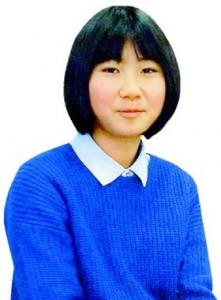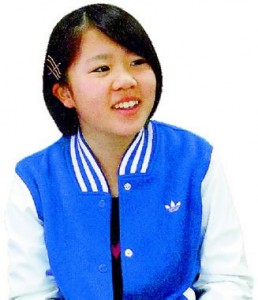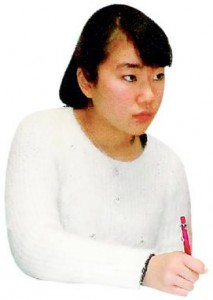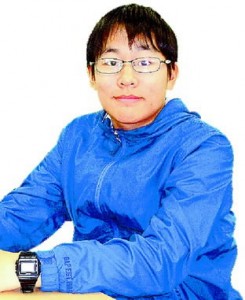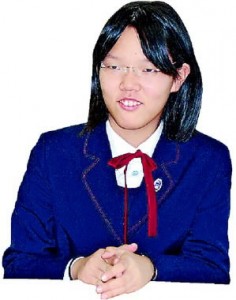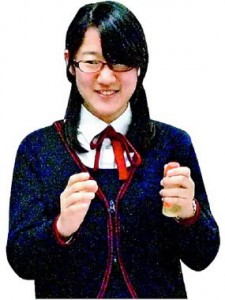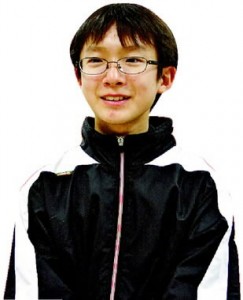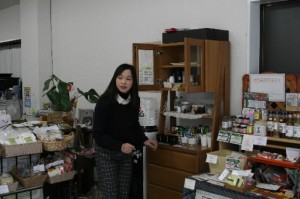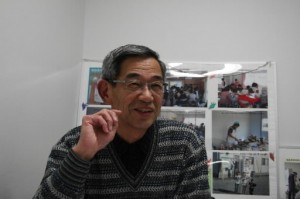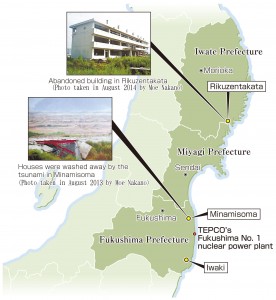Peace Seeds: Teens in Hiroshima Sow Seeds of Peace (Part 5)
Mar. 25, 2015
Part 5: Four years after the 3.11 disaster, what we can do now
Four years have passed since the Great East Japan Earthquake and the accident at the Fukushima No. 1 (Daiichi) nuclear power plant. The catastrophic tsunami triggered by the earthquake also left many towns in ruins. The reconstruction efforts have progressed slowly, and many evacuees are still unable to return to their homes. They continue to live with uncertainty over the future.
The junior writers were shocked by the disaster, which went beyond the scope of our imagination. We have raised funds for the victims and visited the disaster zone to gather news.
With interest in the disaster now waning, seven junior writers interviewed the members of Asuchika, a group of evacuees who are living in Hiroshima, and Minamisoma Borabas Oentai (Minamisoma Volunteer Bus Supporter Squad), a group of volunteers who have been active in the disaster-stricken area. One of the junior writers also heard from her father about his experience as a volunteer in the region. Their focus has been on learning about the disaster and considering what young people can continue to do to help. They have also come to understand the preciousness of life and the importance of strong bonds between people, which can eventually lead to a peaceful world.
Face the reality, learn from it, and make use of this knowledge for the cause of peace
Discussion with the junior writers
Learning the reality, same for war and poverty (Miyu Okada)
Met with people’s kindness in Minamisoma, Fukushima Prefecture and Rikuzentakata, Iwate Prefecture (Moe Nakano)
Learned the importance of taking action (Shiori Niitani)
Will consider what I can do to help (Hisashi Iwata)
Hope to work to support people’s lives in the future (Yoshiko Hirata)
Must be prepared for huge earthquakes (Chiaki Yamada)
Will not forget the disaster even if the media covers it less often (Hiroyuki Hanaoka)
〈3.11〉 On March 11, 2011, a massive earthquake of magnitude 9.0 occurred off the Pacific coast of the Tohoku region. The earthquake triggered a powerful tsunami, and brought devastation to the coast of the Tohoku and Kanto regions. The disaster left more than 18,000 people dead or missing. The tsunami also triggered an accident at the Fukushima No. 1 (Daiichi) nuclear power plant. Many residents around the power plant were forced to evacuate their hometowns because of radioactive emissions from the plant. Many are still unable to return to their homes. (Chiaki Yamada, 15)
What did you think at the time of the 3.11 disaster?
Yoshiko Hirata, 13: I saw the tsunami on TV and felt the horror of natural disasters.
Miyu Okada, 14: I was shocked to see houses swallowed up by the tsunami. I didn’t understand what was happening.
Shiori Niitani, 16: All the TV programs had reports from the disaster zone. It was such an eerie situation. I wasn’t sure if Japan could ever recover.
Hisashi Iwata, 13: At that time, I just felt sorry for the plight of the victims.
Did you get involved in any activities in response to 3.11?
Hisashi: I gave support indirectly by donating money.
Hiroyuki Hanaoka, 13: I also put some money into a donation box, hoping it would be of some help to them.
Moe Nakano, 16: I visited Minamisoma as a junior writer in 2013, and in the following year I went to Rikuzentakata on a separate study tour.
How did you feel?
Moe: I got goose bumps when I saw the silent towns. But the people working to reconstruct their cities treated us very kindly, and I felt energized by them. I realized that the strength of the bonds between people in the community is a key factor in the reconstruction efforts.
Chiaki Yamada, 15: My father works for a company that has a factory in the Tohoku region. So he felt an urge to do something and visited Minamisanriku in Miyagi Prefecture after the disaster. But he told me that, as an individual, there wasn’t much he could accomplish and, at one point, he wondered if going there had been the right thing to do.
What did you think when you interviewed members of Asuchika and Minamisoma Borabasu Oentai?
Miyu: I again realized the preciousness of life, like when I’ve listened to the accounts of A-bomb survivors.
Moe: I thought empathizing with people was important. It’s vital for human beings to squarely face their problems together. I believe it’s this attitude that will eventually lead to realizing a peaceful world.
Shiori: From Asuchika, I learned the importance of empathizing with people, and from Borabas Oentai, I learned the importance of taking action.
Hisashi: I interviewed a member of Asuchika about what happened at the time of the disaster and learned that the members of the group are uncertain about their future. I realized that they were having a really hard time.
How should we view 3.11 and what can we do at this point?
Miyu: I’ve come to understand the importance of knowing the reality of a situation and learning from it. It’s the same when it comes to war, poverty, and genocide.
Moe: I think it’s important that we consider what we can do and share ideas with our friends. I’m now making presentations and exhibits to report on what I’ve learned. I want to take action with my classmates so the experience of the disaster won’t be forgotten.
Hisashi: I’ll think about what I can do for the people who suffered the disaster.
Hiroyuki: There has been less news related to the disaster, and I’m afraid it may be forgotten. I’ll continue to consider what I can do for the victims.
Chiaki: I regret that I didn’t listen to my father’s story earlier. Based on what I’ve heard, I’ll continue thinking about issues involving unexpected disasters, like the earthquake.
Yoshiko: I’ve thought about how I can get involved. Now I hope to work in an area where I can help support people’s lives in the future.
Aya Miura, head of Asuchika: Don’t take peace for granted
Asuchika is a group of people who moved to Hiroshima after the Great East Japan Earthquake and the nuclear accident. The group helps newcomers lay a foundation for their lives in Hiroshima, make friends with others who share the same feelings, and begin a new chapter in their lives. Asuchika is a combination of asu (tomorrow) and chikara (power) and means “power to move toward tomorrow.”
The group has a total membership of 340 people in 120 households. Members have come to Hiroshima from Iwate, Miyagi, and Fukushima prefectures as well as from the Kanto region. The Community Center Tanemaku Hiroba, located in Nishi Ward, is where members of the group, its supporters, and local people freely gather.
Aya Miura, 42, is from Iwaki, Fukushima Prefecture. She said, “We must never take it for granted that we live in peace.” She stressed that our generation must see things with open minds, offer a helping hand to people facing difficulties, and appreciate our lives. (Miyu Okada, 14)
Kensei Naganaka, head of Minamisoma Borabas Oentai: Seeking to empathize with sufferers
The group Minamisoma Borabas Oentai charters buses to bring volunteers from Hiroshima to Minamisoma, Fukushima Prefecture, where they visit residents in temporary housing and provide opportunities for friendly chats over cups of tea.
Minamisoma is located about 20 kilometers from the Fukushima power plant and there are restricted-access areas not far away. Volunteers get together with local residents, cook okonomiyaki, which is a Hiroshima specialty [a kind of crepe made with pork, cabbage, and special sauce], and entertain them with their abilities.
The group, which has 40 members, has visited Minamisoma 20 times to date. People from Fukushima are also invited to Hiroshima to relate their experiences of the disaster.
Kensei Naganaka, 65, the head of the group, said, “I have always considered how we can really empathize with people, not just how to please them.” He continued, “I have come to realize the importance of reflecting on myself. I want young people to know that.” This might be a small thing, but I believe it is an important step toward building peace. (Article and photo by Moe Nakano, 16)
Junior writers’ postscripts
If I had not been involved in the news gathering activities in the Tokoku region, I would have felt that the disaster was somebody else’s problem. As time goes by, memories of the disaster are growing dim and many people have started to forget it. Through our articles, I would like to provide opportunities for people to turn their eyes back to the Great East Japan Earthquake. (Moe Nakano)
I have learned through my news gathering that there is a mountain of problems to solve. In particular, it will take a long time to heal people’s emotional wounds. I will consider what I can do and how I can empathize with those who suffered the disaster. (Shiori Niitani)
Through covering the news, I have learned things I didn’t know about the 3.11 disaster. Each person has a different story when it comes to their decision to move to Hiroshima. As Aya Miura said, we must not have preconceived ideas about people before we listen to them. I will also value life in general and every minute of my own life. (Miyu Okada)
This was the first time I took part in gathering news as a team. Because I was in a lower grade when the 3.11 disaster occurred, I didn’t think about helping directly, like participating in volunteer activities. But the reconstruction of the disaster areas is still going on, and all of us should consider what we can do to help. (Hiroyuki Hanaoka)
It was my first experience meeting someone who had suffered a disaster. She seemed very nice, but I learned that she has gone through a lot of difficulties since that time. I felt keenly that she has been working so hard, despite her sorrow. I’ve learned a lot. (Hisashi Iwata)
After I heard from my father about his experience as a volunteer, I thought I should be making more efforts. One of the reasons I wanted to become a junior writer is to learn more about the Great East Japan Earthquake, which I could have done if I had tried. I want to listen to more accounts of the survivors, and take action. (Chiaki Yamada)
What is Peace Seeds?
Peace Seeds are the seeds of smiles which can be spread around the world by thinking about peace and the preciousness of life from various viewpoints. To fill this world with flowering smiles, 44 junior writers, from the sixth grade of elementary school to the last year of high school, choose themes, gather information, and write articles.
(Originally published on March 12, 2015)

